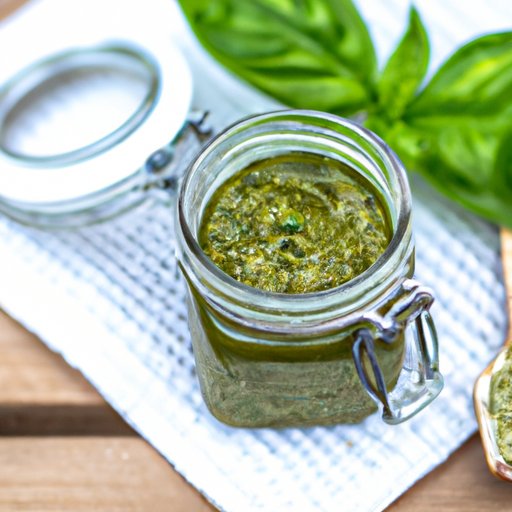Introduction
Basil pesto is a flavorful Italian condiment made from a blend of ingredients including fresh basil leaves, garlic, olive oil, pine nuts, Parmesan cheese, and salt. It’s savory and can be used in a variety of dishes, from pasta sauces to marinades. But is basil pesto a healthy choice for those looking to improve their diet? In this article, we’ll examine the nutrition profile of basil pesto, explore its potential health benefits and risks, and look at different types of pesto and ways to incorporate it into meals.
Comparing Basil Pesto to Other Healthy Options
When choosing any food, it’s important to compare it to other options. This helps you determine if it’s a healthier choice than other foods that are available. When compared to other condiments like mayonnaise or ketchup, basil pesto is certainly a healthier option. It has fewer calories, less fat and sodium, and more vitamins and minerals.
In terms of health benefits, basil pesto is rich in antioxidants, which can help reduce inflammation and protect against disease. It also contains fatty acids that have been linked to better heart health and cognitive function. Additionally, research suggests that the combination of basil, garlic, and olive oil found in pesto may have anti-cancer properties.

Exploring the Nutrition Profile of Basil Pesto
To get an accurate understanding of whether or not basil pesto is a healthy choice, it’s important to take a closer look at its nutrition profile. Here’s a breakdown of the macronutrients, vitamins, minerals, and other nutrients found in pesto.
Macronutrients
One tablespoon of basil pesto contains approximately:
- 45 calories
- 4 grams of fat
- 1 gram of protein
- 2 grams of carbohydrates
Vitamins and Minerals
Basil pesto is a good source of several essential vitamins and minerals, including:
- Vitamin K – helps with blood clotting and bone health
- Vitamin A – supports eye health and immunity
- Vitamin C – aids in wound healing and iron absorption
- Calcium – helps keep bones and teeth strong
- Potassium – helps regulate blood pressure
- Iron – helps produce red blood cells
Other Nutrients
Basil pesto also contains other beneficial compounds, such as polyphenols, which are plant compounds with antioxidant properties. It’s also high in healthy monounsaturated fats, which can help lower cholesterol levels.
Examining How Basil Pesto Can Fit into a Healthy Diet
So, how can you incorporate basil pesto into a healthy diet? The key is moderation. Eating too much of any food can lead to weight gain and other health issues, so it’s important to limit your intake. A suggested portion size for basil pesto is one tablespoon per day. However, if you’re trying to lose weight or manage a chronic condition like diabetes, you may want to limit your intake even further.
When it comes to incorporating basil pesto into meals, there are plenty of options. Try using it as a sauce for vegetables, a spread for sandwiches, or a marinade for meats. You can also mix it with pasta or rice for a quick and flavorful meal.

Analyzing the Potential Health Risks of Eating Basil Pesto
While basil pesto can be a healthy addition to your diet, there are some potential risks to consider. For those with allergies, basil pesto can cause an allergic reaction. Additionally, it’s high in sodium, so people who need to watch their sodium intake should limit their consumption of pesto. Finally, because pesto contains dairy products, it’s not suitable for vegans or those who are lactose intolerant.
Reviewing the Different Types of Basil Pesto
There are many different types of basil pesto available. Traditional pesto is made with Parmesan cheese and pine nuts, but there are also vegan versions that use nutritional yeast instead of cheese. Additionally, there are low-fat varieties that contain less olive oil and more herbs.

Investigating the Culinary Uses of Basil Pesto
Basil pesto isn’t just for pasta dishes. It can be used in a variety of ways, including as a marinade, a sauce, or a spread. It pairs well with grilled meats, roasted vegetables, and salads. You can also use it as a dip for chips or crackers, or as a topping for pizza.
Conclusion
Basil pesto is a flavorful condiment that can be a healthy addition to your diet. It’s low in calories and high in vitamins and minerals, and it contains healthy fats and antioxidants. However, it does contain allergens and is high in sodium, so it’s important to consume it in moderation. There are different types of pesto available, including traditional, vegan, and low-fat varieties, and it can be used in a variety of dishes. If you’re looking to add flavor to your meals while improving your overall health, basil pesto is a great choice.
(Note: Is this article not meeting your expectations? Do you have knowledge or insights to share? Unlock new opportunities and expand your reach by joining our authors team. Click Registration to join us and share your expertise with our readers.)
